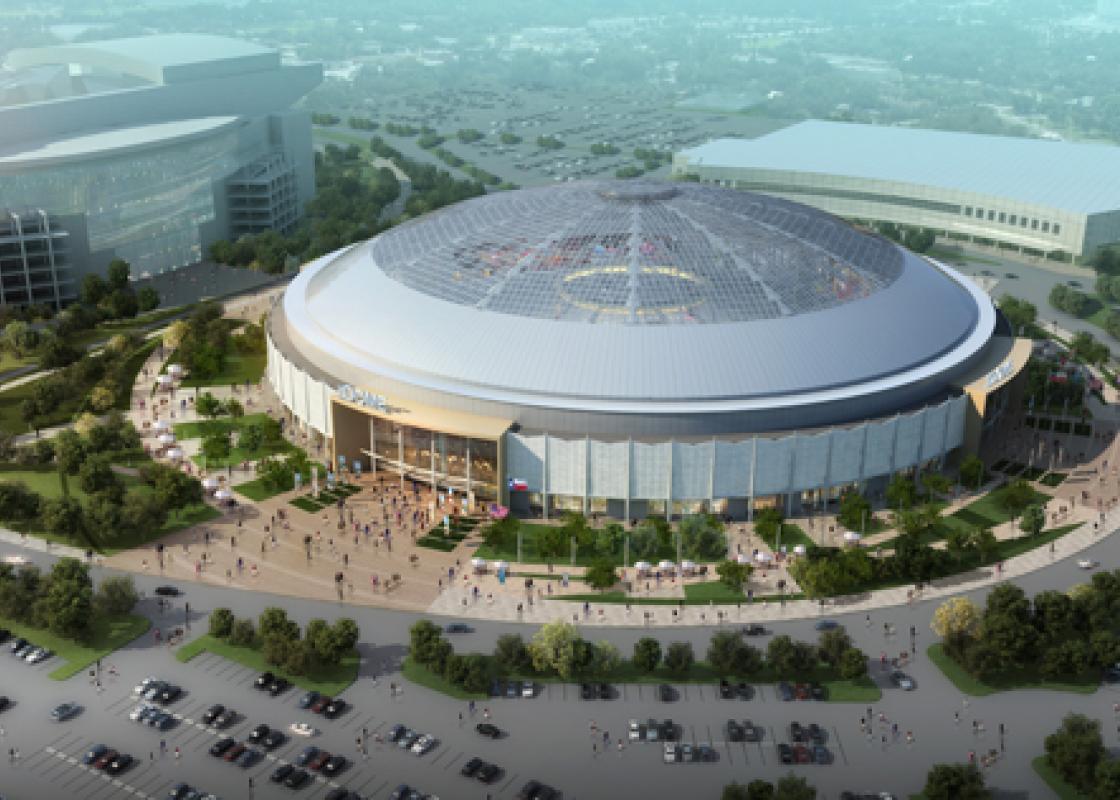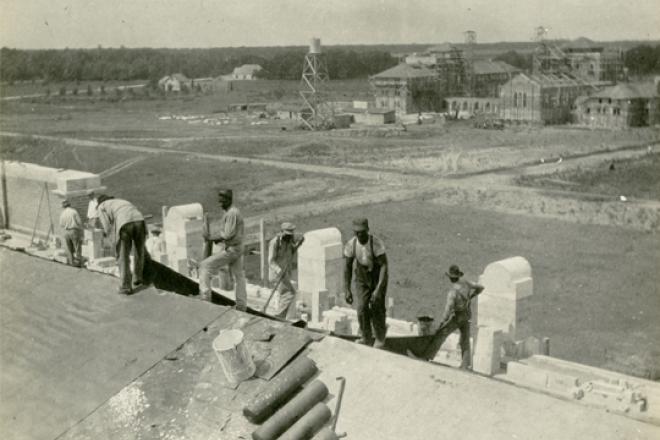Harris County voters will decide in a week what to do with the Astrodome. A ballot measure, known on mobile billboards and Twitter feeds as Proposition 2, asks taxpayers to foot a $217 million renovation, designed by Kirksey, that would convert the Dome into convention space. The rendering above shows what that might end up looking like: The stadium's below-grade playing field would be raised; the rainbow seats removed; exterior scrubbed; entrances enlarged with glass panels; and the concrete perimeter made into greenspace. If the measure fails, it's likely that the Dome will be demolished.
Cite has been covering such propositions---and the rest of the Dome drama---over the years:
- Bruce C. Webb, "Diamond in the Round: The Astrodome Turns 25" (Cite 24)
- John Pastier, "Shaggy Rug Story: The Greening of the Astrodome" (24)
- Webb, "Full Circle" (34)
- Larry Albert, "Last Roundup at the Astrodome" (55)
- Brad Tyer, "Big Bad Dome: How the Astrodome Killed Rock & Roll" (55)
- Webb, "Making a Dome Deal" (64)
- Madeleine McDermott Hamm, "The Astrodome: The Glory Days, the decline, the future" (76)
In 2009, OffCite staged an online public forum led by University of Houston architecture professor Webb and current chair of the "Save Our Astrodome" campaign Hamm. That forum allowed you to voice concerns, relive memories, suggest ideas, and ponder what the Astrodome---and architectural preservation in general---might mean to this ephemeral city.
This week, OffCite has invited Webb and Hamm to revisit their positions about the Dome in advance of next week's vote.
Webb writes:
Well, we’re kidding ourselves if we think the Astrodome is a Houston icon---our Eiffel Tower---to anyone under 50 years of age. But it is a part of history---a marker of the most innovative, future-spirited period of the city that built it. It was the pioneer and precursor to a generation of new stadiums all across the country.
The essence of the Dome has always been that overwhelmingly huge, ineluctable air-conditioned space inside. It was indeed the model of the futuristic piazza. Displaced of course, but this is Houston. It’s has no architectural features to endear it; it resembles more an oil storage tank than the Coliseum the building that supposedly inspired Judge Hofheinz. But it sits there just outside of consciousness the way bland, utilitarian things are supposed to. The idea of hanging light boards and laser displays and whatever new electronic wallpaper that comes along to agitate the eyes (along with, no doubt, country-and-western songs blaring from tinny speakers to pump in a whiff of festival) just makes it all seem so much uglier. It’s clear the imagineers of “The New Dome” experience don’t know what to do with it either. So they propose a kind of heterotopia, many displaced things brought together in a displaced location. Gateway? To what?
Don’t get me wrong. I have been a big supporter of saving the Dome since it was abandoned. There have been many interesting proposals. (My favorite: A national center for sports medicine and Olympic training.) But for now we’re still talking about a proposal that would clean (remediate) it up inside, give it a dark gray paint job on the outside and see how many things we can do inside the big room. My bet, in this case, is if you fix it they will come.
Hamm writes:
The mid-century architectural and engineering marvel known as the Astrodome set a new standard in stadium design that would be widely imitated. Once again the Astrodome promises to be a trend-setter, an example of progressive preservation rather than wasteful demolition.
In its glory years, the Astrodome hosted baseball, football, rodeos, circuses, concerts, and so much more. The repurposed Dome will again be a place for the public, a venue for festivals, exhibitions, conventions, graduations, and with the addition of temporary grandstands, high school football and other sporting events.
The proposed 21st century, state-of-the-art redesign will include wide expanses of glass at four entrances to add to the natural light, while maintaining the familiar, historic shape of the Dome. Inside the main floor will be raised to street level for easy access. Undoubtedly the most important feature of the air-conditioned interior---for both versatility and visual awe---is the unique 350,000 square feet of unobstructed, column-free space with a 175-foot ceiling. The grounds outside will be leveled and landscaped to create a park-like environment, with a 400,000-square-foot plaza, perfect for outdoor activities.
While we applaud and support the energetic plans to bring the Astrodome back to life as a landmark venue for public events and activities yet to be imagined, we have a small bone to pick with the proposed name, “The New Dome.”
No!
It’s not just a dome---after all, it inspired other domes. If Judge Roy Hofheinz had not dubbed the Harris County Domed Stadium as the “Astrodome” back in 1965---a genius marketing move---it surely would not have become the famous symbol of Space City Houston. It is and must continue to be the Astrodome! Sure, around Houston we often call it the Dome, but beyond our city, our iconic landmark is known as the Astrodome.
If you referred to “the Bridge” or “the Tower,” who would know you meant the Golden Gate Bridge or the Eiffel Tower? If a name goes up on our proud, renewed “Eighth Wonder of the World” (it never needed a sign before), it must be the Astrodome.
The vote's on November 5.
Two days later, The Architect's Newspaper plans to launch its Southwest edition, which will feature the results of this fall's design competition, "Reimagine the Astrodome."










